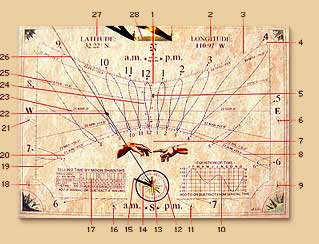Sundial Functions

All my sundials do much more than just tell time! All sundial functions use the sun's position in the sky and the shadow of some attached object to point to markings on the dial face. Some dials, like the heliochronometers show Standard (watch) Time directly and perform a great number of functions. Most types though, just indicate the times and the directions of sunrises and sunsets on the equinoxes and solstices. I design my sundials with built-in longitude correction which makes telling watch time easier. The clients can choose to have the sundial show Standard Time or Daylight Saving Time or even both times!
You read the time just like an ordinary clock, with the gnomon's shadow serving as the clock hand, rotating clockwise about the center in the northern hemisphere, or counterclockwise in the southern hemisphere. Usually, if the gnomon is a cable or a rod, you read the shadow from a mentally drawn line that runs down the center of the shadow. If the shadow is from a thick stone or metal sheet gnomon, then you read the edge of the shadow. Estimate Sundial Time by looking at the adjacent time marks on the sundial face. "Guesstimating" the exact time with precision requires a little practice. A well-done time reading should give you correct Standard Mean Time to within 2 to 4 minutes on my 26" dial, or from 30 seconds to one minute on a large 40" dial. To get Watch Time though, you need to convert the Sundial Time by using The Equation of Time Graph which I supply with each sundial. A heliochronometer is a sundial that shows Standard Time accurately and directly. The shadow of its nodus can show Standard (watch) Time without corrections since the face has the curious, figure-eight analemmas – a graphic representation of the annual apparent motion of the sun along the plane of the Earth's orbit drawn into its face. I place little round circles (beads) on the analemmas so that they look rather like a twisted strand of pearls. These beads represent the dates, which means that the analemmas can also show the date.

If a sundial has a nodus- a little ball which casts a shadow to indicate the time and/or the date on a dial face located on its cable gnomon, then its shadow can tell the height of the sun above or below the celestial equator (declination). This varies between a value of 0° on the equinoxes and +/- 23.5° on the solstices. Since the solar declination changes with the date, the declination lines on the face can also show the date or an anniversary. Most of my sundials don't have a nodus, declination and date lines, or analemmas, but my heliochronometers do. However, you can still estimate the date on other sundials by the position of the vertical brass finial's shadow at the moment of sunrise and sunset.
Some dials have a vertical brass pointer in the center of a compass rosette which indicates the sun's direction (azimuth) and height above the horizon (altitude). Often I engrave a 360-degree horizon (azimuth) scale around the circumference of the dial for use as an accurate, giant compass. Your dial's face will be much more accurate because it is so much larger. Using it, one can take precise compass bearings of any object on or near the horizon.
To see detailed drawings showing sundial functions on different types of sundials, click on the sundial type:
♦ Analemmatic Sundial Functions
♦ Horizontal Sundial Functions
